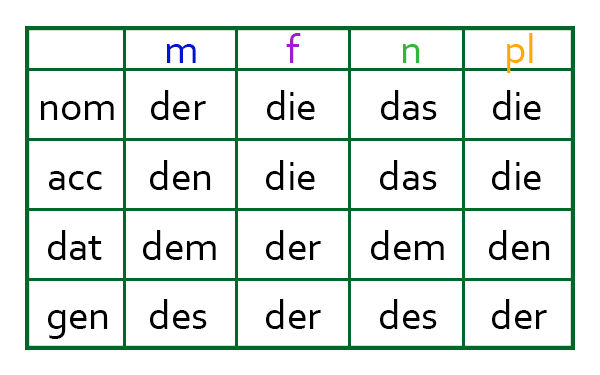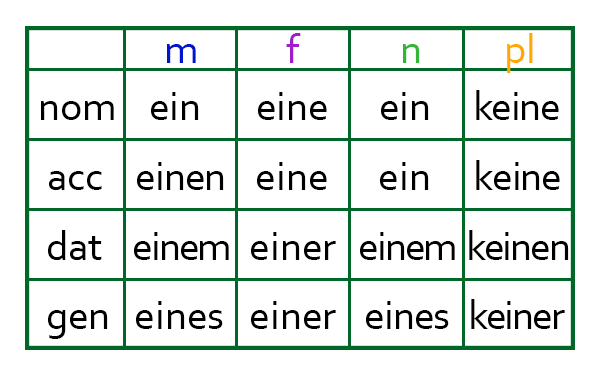An article is a word which comes before a noun to get a grammatical grip on the noun within the sentence and help to show how we should be interpreting what the noun’s place is in the context of the rest of the text. The articles in English are ‘the’ and ‘a’. In German, ‘der/die/das’ and ‘ein/eine/ein’. ‘The’ and ‘der/die/das’ are called ‘definite articles’ because they demonstrate that the noun we’re talking about is a ‘definite’ thing which we already know or already has a set identity in the context of the text. ‘A’ and ‘ein/eine/ein’ are called ‘indefinite articles’ because they demonstrate that the noun is just one of its type, but we don’t know specifically which one it is. This sounds complicated, but it’s essentially the difference between saying:
‘I looked out of the window and the car was in the driveway, smashed up and on fire.’
and
‘I looked out of the window and a car was in the driveway, smashed up and on fire.’
Do you see how in the second sentence, it’s clear that I have no personal connection to the car in my driveway – it seems to be some stranger’s car which yobs have dumped in my driveway.
The definite and indefinite articles change according to the gender and case of the noun, as follows:
For the indefinite articles we use ‘kein’ in the plural column because there’s no such thing as ‘a chickens’, but it is possible to say ‘no chickens’. Kein behaves in exactly the same way as the indefinite article. The indefinite articles go like this:
Handy Hints!
- In German, often the definite article is used where you wouldn’t use it in English, such as with numbers (‘Die Vier’) or days/dates (‘am Freitag’ means ‘on Friday’, but ‘am’ is a shortening of ‘an dem’). For example, ‘Meine Telefonnummer ist die 01555 555 555.’ You can even go as far as to use it with people’s names: ‘Und was macht jetzt die liebe Filomena?’ It doesn’t really mean anything when you use this construction, but it’s a casual way of speaking and particularly with people’s names it suggests familiarity with or affection for the person being referred to. And it sounds hilarious in my head: ‘Yo, where’s the Steve?’
- ‘Ein’ can also be used all by itself in the sense of ‘one’, referring to something you’ve already mentioned. For example, ‘Brauchst du einen Stift? Nee, ich habe einen.’ – ‘Do you need a pen? No, I’ve got one.’ As you can see, in German the form of ‘ein’ always needs to agree with the gender of the thing it is referring back to and the case in which it is being used in the sentence.

